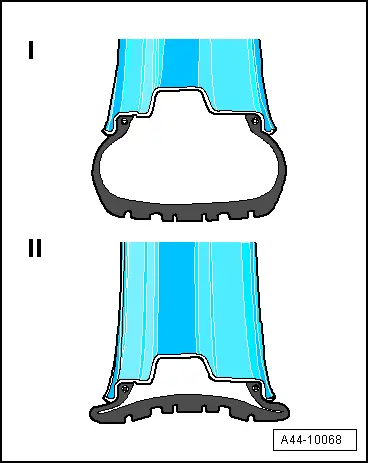Audi Q3: Tires with Emergency Running Characteristics, SST (Self-Supporting Tire)
 Caution
Caution
It is mandatory for run-flat tires to have a tire pressure monitoring system in the vehicle.
 Note
Note
- Only vehicles with a tire pressure monitoring system are equipped with SST tires. This warns the driver when tire pressure falls below a certain value.
- Tire damage and the pressure loss resulting from it is not always recognizable.
- Driving can continue at a maximum of 80 km/h (50 mph) up to a distance of 50 km (31 miles) with complete loss of pressure.
Observe the special mounting information for SST tires.
Mixed installation of SST tires and standard tires is not permitted, and not on the same axle. A standard tire can only be installed in exception cases for a short time or a limited driving distance. However, the SST-specific flat running characteristics no longer apply. The driver must be explicitly informed of this.
In an emergency, the responsibility lies with the driver to decide after checking whether the affected tire can be driven farther. Refer to the Owner's Manual.
Retrofitting only with tires approved for this (EH2 - extended hump rim contour).
SST Tires, Construction
 Caution
Caution
It is mandatory for run-flat tires to have a tire pressure monitoring system in the vehicle.
Run-Flat Tires, Removing and Installing. Refer to → Chapter "Run-Flat Tires, Removing and Mounting".
A tire pressure monitoring display is necessary when using run-flat tires.
Tire damage and the pressure loss resulting from it is not always recognizable.
SST tires are identified with a special code (RSC = Run-flat System Component) on the side wall.
The identification on the side wall of run-flat tires can differ depending on the manufacturer.
Self-Supporting Tire stands for a tire system with emergency running characteristics in the event of a loss of pressure. In the event of a flat tire, the driver can continue driving to a limited extent to the next workshop Owner's Manual.
Advantage
SST tires make it possible to drive up to 50 km (31 miles) at a maximum of 80 km/h (50 mph) even with a complete loss of pressure.
Driving style, speed, road surface, weather conditions, tire condition and tire load influence the distance.
With SST tires, it is not necessary to immediately change a tire when it suffers from a complete loss of pressure (for example, no tire changing in an area with low visibility or in dangerous conditions).
Braking, steering and driving performance remain for the most part after the tire looses pressure.
A spare wheel is no longer necessary when using SST tires. From the view of the customer, this means: saving space and weight.
Technology in Detail
Standard Tires without Emergency Running Characteristics
- -I- standard tires with air

- -II- standard tires without air
- If the standard tire loses air, the rim presses the side wall together. The rubber in a flat tire is heated strongly and quickly loses its properties.
SST Tires with Reinforced Side Wall
The self-supporting, reinforced side walls form the basis of SST technology.
- -I- SST tires with air

- -II- SST tires without air
- Especially thick side walls -A- support the empty tires on a standard rim and the vehicle remains maneuverable. A special rubber mixture reinforces the tires and supports the vehicle in an emergency.
The reinforced side walls, unlike a standard tire, prevent the tire flanks from pinching between the road and rim when flat.
Difference in Version H2 and EJ2 Extended Hump Rim
- The increased hump on the EH2 Extended Hump Rim prevents the SST tire from springing off when pressure is lost
- EH2 builds up toward the center of the wheel
 WARNING
WARNING
The clearance to the brake is reduced.


